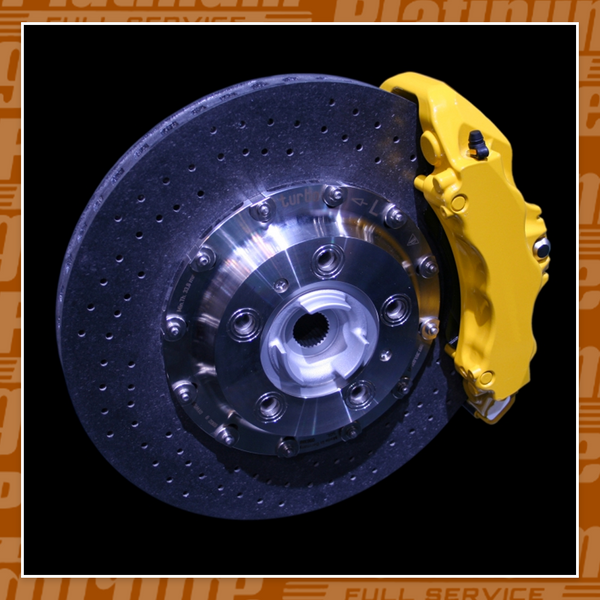Brake System Repair
Full-Service Brake Services in Gillette
Brake Repair Services in Wyoming
Many of today’s cars have disc brakes in the front and drum brakes in the back. Brakes rely on friction, which is supplied by either a brake pad or a brake shoe to slow and stop your car. To stop a wheel, a disc brake uses a caliper fitted with brake pads to grab a spinning disc or rotor. A drum brake has a wheel cylinder that pushes a brake shoe against the inside of a spinning drum.
Brake systems are fairly simple and incredibly effective technologies, but when they need a mechanic’s attention, they give certain warning signals. For example, a low or spongy pedal can mean that there’s air in the hydraulic system. A pulsing feel in the brake pedal or wheel shake during braking is also an indication of an issue with the brake rotor. A red brake-warning light that stays on could mean that there’s an imbalance in your hydraulic system or low fluid. While some brake noises are normal, continuous squeals and a grinding sound almost always mean that it’s time for new brake pads or shoes. Anytime you notice something irregular about your brakes, it’s a good idea to have them checked out by a brake systems specialist.

Our Brake System Repair Services Include:
- Pad Replacement
- Line Replacement
- Hose Replacement
- Wheel Cylinders
- Master Cylinders
- Emergency Brakes
- Brake Drums
- Brake Rotors
- Power Boosters
- Anti-Lock Systems
Brake System Repair
Benefits
Why It’s Important to Flush Your Brake Fluid
The brake fluid flush is one of the most frequently forgotten car maintenance services. Many owners do not even realize that a brake fluid flush is an item that should be on their maintenance list and others feel as though their mechanic is trying to take advantage of them or sell an unneeded service when a brake fluid flush is recommended. A vehicle’s brake fluid does need to be flushed periodically in order to help prevent costly brake system repairs.
Unfortunately, vehicle manufacturers have omitted brake fluid service from their service schedule. We suspect that this resulted from manufacturers trying to reduce the apparent cost of long-term vehicle maintenance in an attempt to make their products more appealing. This isn’t much of a concern for the first couple of years but with the struggling economy and many people making the choice to keep their vehicles longer, brake fluid maintenance becomes important.
Brake fluid should be flushed periodically because it is a hygroscopic fluid, meaning that it readily absorbs and retains moisture. It may seem a bit odd at first glance, but that is exactly what we want the brake fluid to do. With the understanding that many of the brake system components are made from metal, we can quickly see that moisture is the enemy. Brake fluid, by absorbing any moisture that gets into the system and retaining it, helps to prevent moisture-related corrosion and failure of internal brake system components. Even the highest quality brake fluid can only retain so much moisture, however, so it periodically must be flushed from the system and replaced with new fluid.

Determining When It’s Time to Change Brake Fluid
There are special test strips and other similar items available to help determine when the fluid is in need of changing, but the best method is to analyze the color of the brake fluid in your vehicle’s brake fluid reservoir. Fresh/new brake fluid is clear in color with a very slight yellow hue. Brake fluid which has served its useful life and is in need of change is deeper amber in color (even brown, in some cases). The use of a flashlight can be helpful in gaining an understanding of brake fluid condition. Use the flashlight to shine through the master cylinder of most late-model vehicles. For older vehicles with metal master cylinder reservoirs, shine the light down from the top and look through the fluid to the bottom of the reservoir. If the fluid has a heavy amber hue, the fluid is ready to be replaced.
Routine Brake System Maintenance
A good general rule of thumb on the frequency for having your modern vehicle’s brake fluid flushed is to have it done every two years, especially on those vehicles equipped with antilock braking systems. Years ago, prior to the advent of antilock brakes, flushing the brake fluid was not as much of a concern. The more intricate fluid circuitry of the hydraulic control units on today’s antilock brake and traction-control equipped vehicles are much more sensitive to moisture and small particulate debris. Additionally, the actuation of these systems during braking or traction controlled events generate heat which further contributes to the breakdown of the brake fluid. With the potential of vehicle safety concerns and brake system repairs that could cost hundreds of dollars, the money spent on a brake fluid flush every two years is well worth the peace of mind.
Schedule Your Visit Today
Whether your check engine light is on or your car is blowing massive plumes of blue smoke, drive or tow it to Platinum Full Service Garage for car engine repair. We'll start with a thorough diagnosis, let you know what we find, and come up with a game plan to get you back on the road. Don't wait, call us now at 307-682-0092 or fill out our contact form below.
